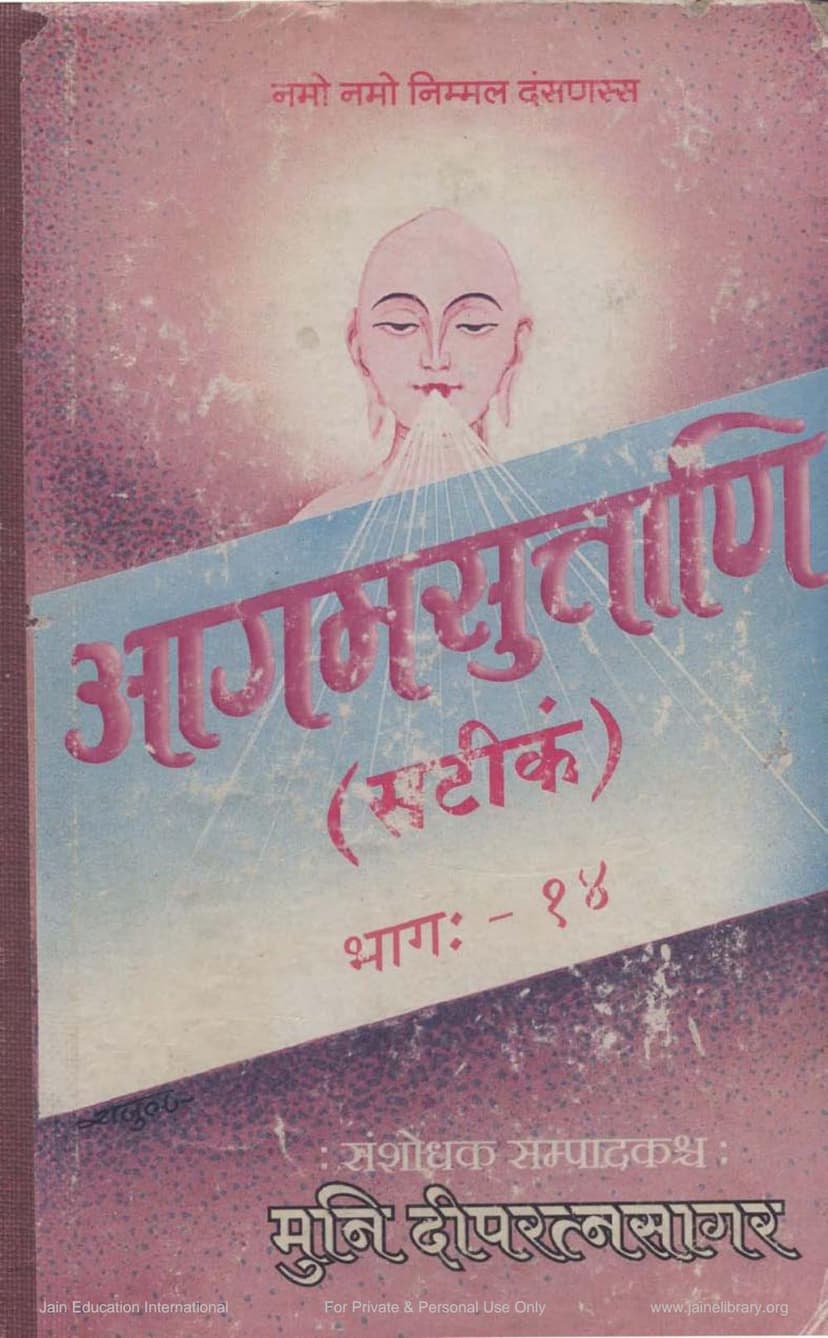Agam Sutra Satik 23 Vrushnidasha UpangSutra 12
Added to library: September 1, 2025

Summary
The provided text is a Jain Agam Sutra titled "Agam Sutra Satik 23 Vrushnidasha UpangSutra 12", authored by Dipratnasagar and Deepratnasagar, and published by Agam Shrut Prakashan. It is part of Volume 14 of the "Agam Suvani (Satik)" series. The text is in Gujarati, with some Sanskrit and Prakrit phrases.
Here's a summary of the key information contained within the provided pages, focusing on the structure and content of the book:
Overall Purpose and Structure:
- Comprehensive Jain Text Series: This book is part of a larger series called "Agam Suvani (Satik)," which aims to provide the Jain Agamas (scriptures) with commentary and explanations. This particular volume (Part 14) covers a specific section of these scriptures.
- Focus on Upanga Sutras and Prakirnaka Sutras: The table of contents (Page 3) clearly indicates that this volume includes:
- Five Upanga Sutras: Nirayavalika, Kalpavatansika, Pushpika, Pushpchulika, and Vrushnidasha.
- Ten Prakirnaka Sutras: Chatursharan, Aturapratyakhyan, Mahapratyakhyan, Bhakta Parigraha, Tandula Vaicharik, Samstarak, Gachchacharak, Ganividya, Devendra Stava, and Maranasamadhi.
- Commentary and Editing: The book is edited and compiled by Muni Deepratnasagar, and it includes commentary (likely "Satik" as indicated in the title and verso pages). The commentary is attributed to Chandrasuri for the Vrushnidasha Upangasutra.
- Catalog Link and Publisher: The catalog link (jainqq.org) and publisher (Agam Shrut Prakashan) are provided, indicating its availability and source.
Specific Content Related to Vrushnidasha Upangasutra (Pages 8-11):
- Identification: The text explicitly identifies itself as "23 Vrushnidasha-Upangasutram (Dwadasam Upangam)" which means it is the 23rd text in the sequence, the 12th Upanga Sutra, and specifically the Vrushnidasha Upanga Sutra.
- Structure of Vrushnidasha: The Vrushnidasha Upangasutra is stated to have "twelve chapters" (duvalas ajhyayana).
- First Chapter ("Nishadha"):
- Invocation: It begins with an invocation to the Pancham Ganadhar Shri Sudharma Swami.
- Introduction to Vrushnidasha: It establishes that Vrushnidasha is the fifth category of Upangas, containing twelve chapters.
- Chapter Titles: The names of the twelve chapters are listed: Nishadha, Madi, Vaha, Vahe, Pragata, Yuti, Dasarathe, Dadhathe, Mahadhasu, Saptadhasu, Dasdhasu, and Shatadhanu (Page 8).
- Narrative Content: The text then dives into the first chapter, "Nishadha," which appears to be a narrative. It describes:
- The city of Dwaraka (Baravai).
- The mountain Revata.
- The Nandana garden.
- The Yaksha Surapriya.
- King Krishna (Vasudeva) and his court, including Balarama, his queens (like Revati), and other significant figures.
- A dream experienced by Queen Revati, which is described as significant.
- The presence of the Arhat Arishtanemi (the 22nd Tirthankara), who delivered religious discourse.
- The narrative progresses, describing societal events, royal activities, and the path of renunciation and spiritual practice.
- It details the journey of a character named Virangada, who becomes an ascetic and attains a celestial abode.
- The story then connects Virangada's past life to the present, suggesting reincarnation and karmic consequences.
- The narrative seems to focus on the virtuous lives, spiritual paths, and eventual liberation of individuals within the Vrushni dynasty.
- Commentary (Vritti): The commentary (Vr.) explains the meaning of certain words and phrases, clarifying the context of the sutra.
- Other Chapters (Pages 11-12):
- Continuation of Chapters: Page 11 mentions that the remaining eleven chapters (adhyayana 2 to 12) should be understood in a similar manner, following the "Sangrahani" (a method of classification or understanding).
- Conclusion of Vrushnidasha: Page 12 marks the completion of the fifth section (Varga) and the Vrushnidasha Upangasutra. It also signifies the completion of the "Nirayavalika Sukhandha" and "Pancha Upanga" section.
Other Supporting Information:
- Table of Contents: The detailed table of contents on pages 3-6 lists all the Sutras included in this volume and their respective page numbers and root (mula) references.
- Acknowledgements (Page 6): The text includes acknowledgments of donors who supported the publication, highlighting the collaborative effort in preserving and disseminating Jain scriptures.
- Verse Counts (Pages 13-21): Pages 13-21 provide extensive tables listing various Jain Agamas, their commentary writers, and the number of verses (shlok praman) for each. This showcases the scholarly effort behind the publication and the vastness of Jain literature.
- Publisher's Information (Pages 27-29): The last pages provide contact details for "Agam Aradhana Kendra" in Ahmedabad and list various publications by "Abhinavshrut Prakashan" and "Agam Shrut Prakashan," further contextualizing the book's place in the Jain literary landscape.
In essence, this document presents a specific Jain scripture, the Vrushnidasha Upangasutra, along with its commentary. It is part of a larger effort to systematically publish and preserve Jain Agamas with detailed scholarly explanations and structural information. The Vrushnidasha Upangasutra, as evidenced by the excerpt from the first chapter, likely narrates stories and teachings related to the Vrushni clan, emphasizing righteous conduct, renunciation, and spiritual attainment.